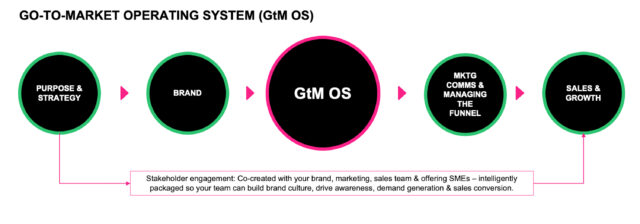As a B2B marketer, do these words seem familiar?
“We keep trying to articulate our difference, but it feels vague compared to our competitors.”
“Our positioning sounds just like everyone else in the market right now.”
“My aim is to find a competitive advantage that no competitor can replicate.”
Finding The Emotional Hook
Business leaders and B2B marketers operating under a single brand — but selling multiple products and services — all struggle to differentiate in markets where it can be incredibly challenging to show how they are genuinely unique in a distinctive, ownable, instantly recognizable way.
Articulating differentiation is hard. Yet, as marketing-oriented leaders, we still aspire to craft positioning that resonates emotionally with buyers and makes our brand and product/service both memorable and compelling.
And it’s easy to adopt strategies that are indistinguishable from competitors.
To stand out, we need to connect with our audience at a fundamental human level. We need to tap into the underlying emotions, pains, needs and desires that drive their behavior. When we understand what truly matters to our customers, we can identify powerful connection points that inspire action.
Today, let’s explore how The Blake Project develops an authentic emotional positioning that can help your brand form meaningful relationships with its audience.
Know Your Audience Deeply
The starting point is getting crystal clear on who you’re talking to. Moving beyond basic demographics and psychographics means understanding what your audience cares about at a core level.
– What motivates them? What gets them excited and invested?
– What frustrates them? What obstacles and pain points keep them up at night?
– What aspirations do they have? What outcomes are they striving for?
– What fears or doubts hold them back? What risks make them uncertain?
Uncover this qualitative, emotional intel through surveys, interviews, social listening, and customer advisory boards. Empathize fully with your audience’s inner world. Once you grasp their deeper emotional essence, you can craft messaging that truly resonates.
Determine Desired Outcomes
With a rich picture of your audience, analyze what goals and outcomes your offering enables them to achieve. Look past surface features to identify the higher purpose or end benefit you provide.
The great news here is that this is also a chance to get inside the heads of your service delivery subject matter experts and leaders. They have so much to bring and to offer, and including them develops a greater sense of connection and ownership to the very assets the business will be using to sell what they do.
For example, a collaboration software company realized its tool wasn’t just about efficiencies — it helped leaders foster innovation and build thriving cultures. The desired outcome was unleashing human potential.
Get specific on the meaningful impacts you uniquely deliver, like:
- Helping people accomplish important life and business goals
- Making complex tasks simpler and less frustrating
- Providing peace of mind in uncertain situations
- Enabling self-expression, passion and purpose
- Overcoming fears and fulfilling meaningful aspirations
Find Powerful Connection Points
Now, match these outcomes to the core emotional drivers within your audience. Where is there strong alignment between what matters most to them and what your brand provides?
Look for connection points like:
- Fulfilling a longing for mastery, achievement, or status
- Providing the freedom people crave
- Helping overcome a major anxiety or source of stress
- Enabling someone to become their best self
- Aligning with a deeper sense of purpose
These intersections represent the most compelling value you offer. This forms the basis for emotional differentiation.
Develop A Core Theme
Distill your key connections down into a simple, coherent emotional positioning theme. This core theme should capture the special way you elevate customers’ lives.
Strong themes often involve:
- Helping people progress on a journey
- Overcoming a frustration or limitation
- Achieving a state of being (belonging, confidence, calm)
- Accomplishing an important goal
- Contributing to a greater good
Emotional themes like these help you stand out from rational, feature-focused B2B positioning. They form the heart of your unique value.
Build Collateral That Brings Your Theme to Life
With a core theme established, infuse it throughout your content and campaigns. Develop messaging, stories and visuals that vividly convey how you impact people’s inner worlds.
- Website copy – lead with emotional headlines and value propositions
- Email sequences – incorporate themed narratives
- Case studies – highlight human stories, transformations and outcomes
- Videos – dramatize how you fulfill yearnings and alleviate pain points
- Sales enablement – train sales people and subject matter experts to consistently connect with what matters most
Articulating Your Differentiator Is Only The Start
People are fundamentally emotional creatures. To craft differentiation that resonates, take the time to truly understand your audience at the human level. Uncover their inner drivers and connect your value to what they aspire to be, achieve, and feel. Distill this into an authentic emotional positioning theme that runs through all your content. This empathetic approach to messaging lets you build relationships beyond transactions and form lasting bonds with the people you serve.

And yet… Crafting differentiation that resonates emotionally and articulating your positioning is only the first step. Next, you need a reliable system to translate these ideas into tangible results.
This is where a Go-To-Market Operating System comes in. A GtmOS™ acts as a detailed creative brief and campaign playbook that aligns positioning, messaging, and marketing across your organization. It provides a blueprint for executing campaigns that drive real awareness, leads and sales.
With a GtmOS™, you can train stakeholders company-wide on conveying your brand story consistently. You can rapidly create campaigns and content that brings your emotional positioning to life across every channel and audience. And you can analyze performance and optimize execution to steadily improve results.
So once you’ve developed a compelling emotive positioning, implement it across the customer journey with a go-to-market system. This combination provides the strategy and execution foundation to truly maximize your marketing. With these tools in place, you can build lasting connections and create a brand that delivers a meaningful difference in your marketplace.
At The Blake Project we are helping clients from around the world, in all stages of development, redefine and articulate what makes them competitive at critical moments of change with our Go To Market Operating System. Please email us to learn how we can help you compete differently.
Branding Strategy Insider is a service of The Blake Project: A strategic brand consultancy specializing in Brand Research, Brand Strategy, Brand Growth and Brand Education




